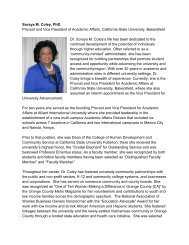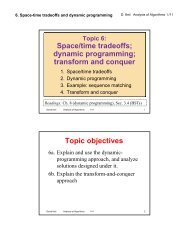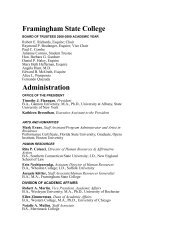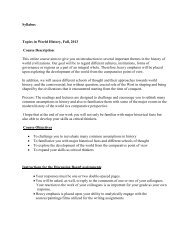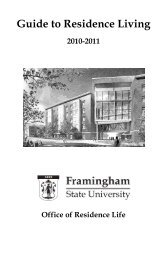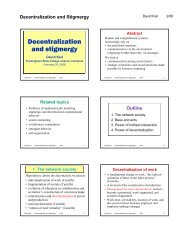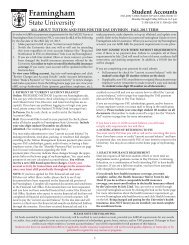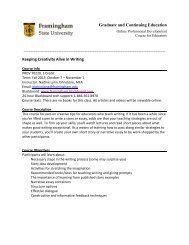2011-2012 Common Data Set - Framingham State University
2011-2012 Common Data Set - Framingham State University
2011-2012 Common Data Set - Framingham State University
You also want an ePaper? Increase the reach of your titles
YUMPU automatically turns print PDFs into web optimized ePapers that Google loves.
I1<br />
<strong>Common</strong> <strong>Data</strong> <strong>Set</strong> <strong>2011</strong>-<strong>2012</strong><br />
Full-time Part-time<br />
Exclude Include only if<br />
they teach one<br />
or more nonclinical<br />
credit<br />
courses<br />
Exclude Include if they<br />
teach one or<br />
more nonclinical<br />
credit<br />
courses<br />
Exclude Include<br />
Exclude Exclude<br />
Include Exclude<br />
Exclude Exclude<br />
Exclude Include<br />
I1 Full-Time Part-Time Total<br />
I1 a) Total number of instructional faculty<br />
176 122 298<br />
I1 b) Total number who are members of minority groups<br />
14 6 20<br />
I1 c) Total number who are women<br />
103 55 158<br />
I1 d) Total number who are men<br />
73 67 140<br />
I1 e) Total number who are nonresident aliens (international)<br />
f) Total number with doctorate, or other terminal degree<br />
I1<br />
149 32 181<br />
g) Total number whose highest degree is a master's but not a terminal<br />
I1 master's<br />
I1 h) Total number whose highest degree is a bachelor's<br />
I1<br />
i)<br />
Total number whose highest degree is unknown or other (Note:<br />
Items f, g, h, and i must sum up to item a.)<br />
I1<br />
j)<br />
Total number in stand-alone graduate/ professional programs in<br />
which faculty teach virtually only graduate-level students<br />
I2<br />
I. INSTRUCTIONAL FACULTY AND CLASS SIZE<br />
Please report the number of instructional faculty members in each category for Fall <strong>2011</strong>. Include<br />
faculty who are on your institution’s payroll on the census date your institution uses for<br />
IPEDS/AAUP.<br />
The following definition of full-time instructional faculty is used by the American Association of <strong>University</strong> Professors<br />
(AAUP) in its annual Faculty Compensation Survey (the part time definitions are not used by AAUP). Instructional Faculty<br />
is defined as those members of the instructional-research staff whose major regular assignment is instruction, including<br />
those with released time for research. Use the chart below to determine inclusions and exclusions:<br />
(a) instructional faculty in preclinical and clinical medicine, faculty who are not paid (e.g.,<br />
those who donate their services or are in the military), or research-only faculty, postdoctoral<br />
fellows, or pre-doctoral fellows<br />
(b) administrative officers with titles such as dean of students, librarian, registrar, coach,<br />
and the like, even though they may devote part of their time to classroom instruction and<br />
may have faculty status<br />
(c) other administrators/staff who teach one or more non-clinical credit courses even<br />
though they do not have faculty status<br />
(d) undergraduate or graduate students who assist in the instruction of courses, but have<br />
titles such as teaching assistant, teaching fellow, and the like<br />
(e) faculty on sabbatical or leave with pay<br />
(f) faculty on leave without pay<br />
(g) replacement faculty for faculty on sabbatical leave or leave with pay<br />
Full-time instructional faculty: faculty employed on a full-time basis for instruction (including those with released time for<br />
research)<br />
Part-time instructional faculty: Adjuncts and other instructors being paid solely for part-time classroom instruction. Also<br />
includes full-time faculty teaching less than two semesters, three quarters, two trimesters, or two four-month sessions.<br />
Employees who are not considered full-time instructional faculty but who teach one or more non-clinical credit courses<br />
may be counted as part-time faculty.<br />
Minority faculty: includes faculty who designate themselves as Black, non-Hispanic; American Indian or Alaska Native;<br />
Asian, Native Hawaiian or other Pacific Islander, or Hispanic.<br />
Doctorate: includes such degrees as Doctor of Philosophy, Doctor of Education, Doctor of Juridical Science, and Doctor<br />
of Public Health in any field such as arts, sciences, education, engineering, business, and public administration. Also<br />
includes terminal degrees formerly designated as “first professional,” including dentistry (DDS or DMD), medicine (MD),<br />
optometry (OD), osteopathic medicine (DO), pharmacy (DPharm or BPharm), podiatric medicine (DPM), veterinary<br />
medicine (DVM), chiropractic (DC or DCM), or law (JD).<br />
Terminal degree: the highest degree in a field: example, M. Arch (architecture) and MFA (master of fine arts).<br />
Student to Faculty Ratio<br />
Report the Fall <strong>2011</strong> ratio of full-time equivalent students (full-time plus 1/3 part time) to full-time equivalent<br />
instructional faculty (full time plus 1/3 part time). In the ratio calculations, exclude both faculty and students<br />
in stand-alone graduate or professional programs such as medicine, law, veterinary, dentistry, social work,<br />
business, or public health in which faculty teach virtually only graduate-level students. Do not count<br />
undergraduate or graduate student teaching assistants as faculty.<br />
CDS-I Page 21



